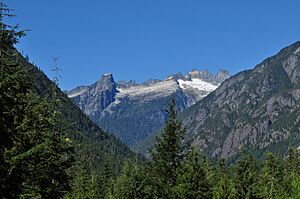Twin Needles facts for kids
Quick facts for kids Twin Needles |
|
|---|---|

Twin Needles, north aspect
|
|
| Highest point | |
| Elevation | 7,936 ft (2,419 m) |
| Prominence | 576 ft (176 m) |
| Geography | |
| Location | North Cascades National Park Whatcom County, Washington US |
| Parent range | Picket Range North Cascades Cascade Range |
| Topo map | USGS Mount Challenger |
| Type of rock | Skagit Gneiss |
| Climbing | |
| First ascent | 1932 |
| Easiest route | Mountaineering |
Twin Needles are two tall, pointy mountains called spires. They are located in a wild and tough area known as the Picket Range. This range is part of the amazing North Cascades National Park in Washington.
One of the spires is about 7,936 feet (2,419 meters) tall, and the other is about 7,840 feet (2,390 meters) tall. They are very close to Mount Terror, which is a bit taller. On the north side of Twin Needles, you can find the Mustard Glacier, which is a big sheet of ice. Another mountain, Himmelhorn, is right to the west.
The very first time someone successfully climbed Twin Needles was on August 17, 1932. The brave climbers were William Degenhardt, James Martin, and Herb Strandberg. You can even catch a glimpse of Twin Needles from the Sterling Munro Trail, which is near the park's visitor center in Newhalem.
Weather at Twin Needles
Twin Needles is located in a special climate zone called the marine west coast climate. This means it gets a lot of weather from the Pacific Ocean. Most of the weather systems start over the ocean and then move towards the Cascade Mountains.
When these weather systems hit the tall Cascade Mountains, they are forced to rise. As the air goes higher, it cools down and drops its moisture. This causes a lot of rain or snowfall on the west side of the mountains. This process is called Orographic lift.
Because of this, the North Cascades get a lot of rain and snow, especially in winter. Winters are often cloudy. But in summer, high-pressure systems over the Pacific Ocean usually bring clear skies. The snow here tends to be wet and heavy due to the ocean's influence. This can make the risk of avalanches higher. All the rain and melted snow from the peaks flow into streams that eventually join the Skagit River.
How the Mountains Formed
The North Cascades area has some of the most rugged and dramatic landscapes in the Cascade Range. You can see jagged peaks, pointy spires, long ridges, and deep valleys carved by glaciers. These amazing shapes were created by geological events that happened millions of years ago. These events also caused the huge changes in height across the Cascade Range, leading to different climates.
The Cascade Mountains started forming millions of years ago, during a time called the late Eocene Epoch. This happened because the North American Plate was slowly moving over the Pacific Plate. This movement caused a lot of volcanic activity. Also, small pieces of the Earth's crust, called terranes, came together to form the North Cascades about 50 million years ago.
Later, during the Pleistocene period (which started over two million years ago), glaciers repeatedly moved across the land. These huge sheets of ice carved out the landscape, leaving behind piles of rock. The river valleys in this area have a "U" shape because of these glaciers. The combination of land being pushed up (uplift) and cracks forming in the Earth's crust (faulting), along with the action of glaciers, created the tall peaks and deep valleys we see in the North Cascades today.




